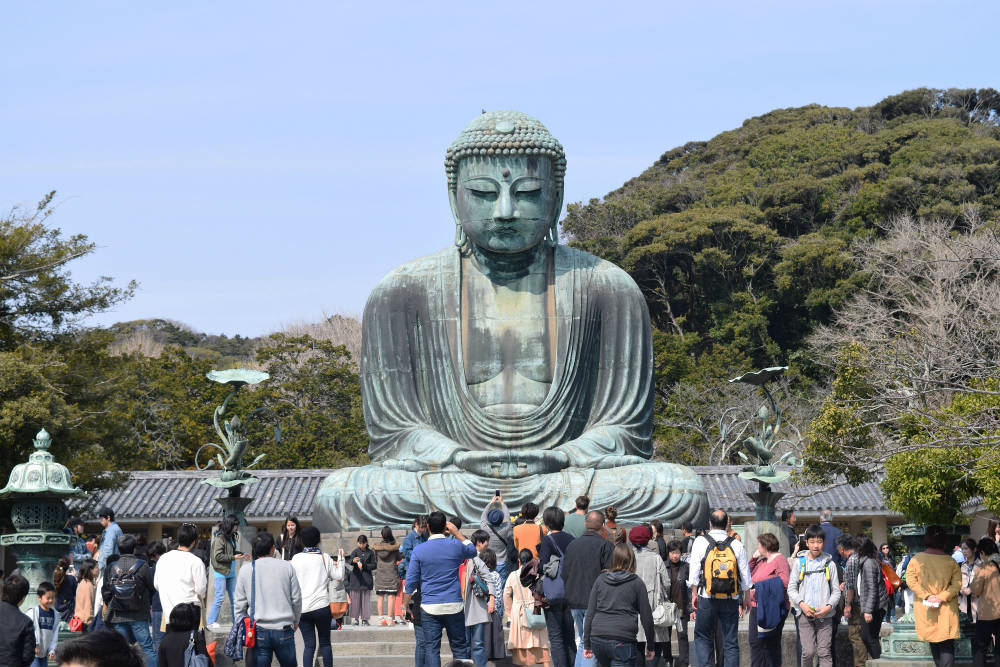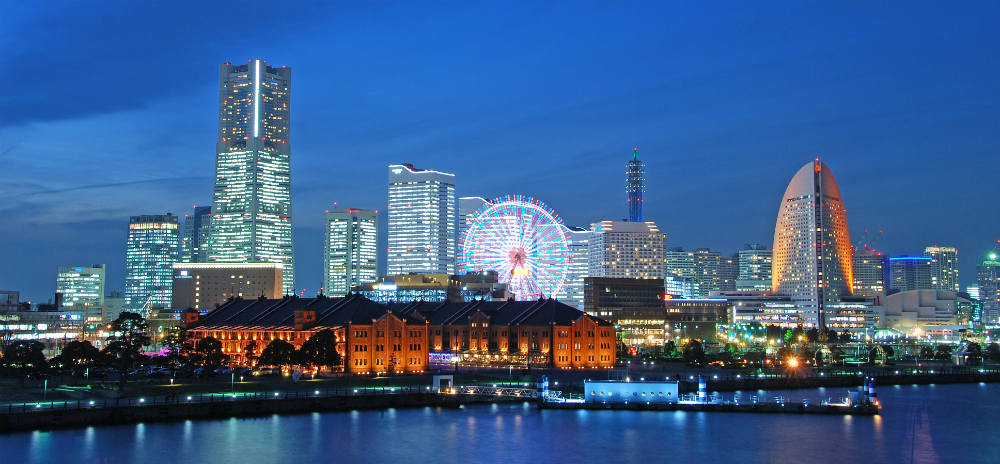Western Kanto Region
Northern/Eastern Kanto | Western Kanto | Tokyo
Kamakura
Japan's capital during the Kamakura Period (1185-1333), Kamakura is just an hour from Tokyo but a visit is like a step back in time. The first seat of the Shogunate, Japan's military government, at its height it was a prosperous city. But now it is a tranquil residential area with many temples and shrines in a mountain setting. The main attractions are signposted in English and can be seen in a day.

The Great Buddha in Kamakura (photo: James Blake Wiener)
South of Kamakura station: near Hase station on the Enoshima Dentetsu (Enoden) Line, Kamakura's most famous sight is the 100-ton, 13.5m-tall Daibutsu (Great Buddha), located in the grounds of Kotokuin temple. Cast in 1252, the Daibutsu was originally housed in a temple building, which was washed away by a tidal wave in 1495. For a mere 20 yen, you can take a quick look inside, though there's not much to see. Nearby is Hasedera Temple, which houses a 9m-high, 11-faced statue of Kannon, the Goddess of Mercy. The statue was carved from a single camphor log in 721AD.
North of Kamakura station: Tsurugaoka-Hachimangu shrine was founded in 1063 although the existing building is a more recent reconstruction. Dedicated to the god of war, the shrine is set on a hill and overlooks Kamakura. At the base of the stone steps leading to the shrine is a gingko tree, behind which the priest Kugyo is said to have hidden before he assassinated the third Shogun in 1219. The shrine is located at one end of Wakamiya Oji street, which runs down to Yuigahama beach.
Kamakuragu is the only shrine in Japan to have been established by an emperor. Noh plays are performed here under torchlight in September. Money washed in the spring water that flows through the cave at Zeniarai-Benten shrine is believed to multiply. True or not, the shrine is always busy. The beautiful Kenchoji temple was founded in 1249 and is considered the greatest of the Gozan, the five great Zen temples of Kamakura. The site was selected by the great Zen monk Enni, who, with the monk Eisai, introduced Zen Buddhism to Japan in the 13th century. Another one of the Gozan, Engakuji temple dates from 1282 and is the headquarters of the Rinzai sect of Zen Buddhism.
Following the coast west from Kamakura brings you to the popular Shonan beach, always full of sun-worshippers and surfers. Nearby is the small island of Enoshima. Although a popular resort, the island is actually a holy place.
Yokohama
Yokohama is Japan's second-largest city and largest port and is located just 30 minutes from central Tokyo. The city has a cosmopolitan image but was only a small fishing port until it became Tokyo's port for international trade in the mid-19th century. It is home to a large Chinatown district, the beautiful Sankeien garden, the Foreign Cemetery, the futuristic Minato Mirai 21 waterfront area, the Bay Stars professional baseball team and F. Marinos J-League soccer team.

The Minato Mirai waterfront at night
From Kannai station on the Keihin Tohoku Line, you pass the 30,000-seat Yokohama Stadium to get to the bustling Chinatown, or chukagai. There are over 100 restaurants, large and small, to choose from and many sell dumplings and other snacks on the street. Passing through Chinatown brings you to Yamashita Park on the waterfront. This popular spot has been overshadowed recently by the nearby Minato Mirai 21 development, which is home to the Landmark Tower, the biggest building in Japan, several hotels and shopping malls. Until recently the world's largest big wheel is located in the Cosmo World amusement park. Boat and helicopter tours of Yokohama Bay are available. In a posh residential area known as The Bluff, there's the Port-Viewing Park (Minato-no-mieru Oka-koen). The nearby Foreign Cemetery is the final resting place of some 4,000 of Japan's early foreign residents. Further east, about 20 minutes by bus, lies the 20-hectare Sankeien, opened to the public in 1906. The beautifully landscaped garden is built around several ponds and also houses historic structures moved here from other areas, such as a villa and teahouse from the early 17th-century. Ships arriving in Yokohama bringing vistors from the Trans-Siberian port of Vladivostok pass under the Yokohama Bay Bridge, opened in 1989. A viewing platform under the bridge affords an excellent view of the waterfront skyline and, if you're lucky, Mt. Fuji behind.
Chichibu-Tama National Park
Located close to Tokyo but mountainous enough to feel remote, this national park is an ideal place to get away from the bustle of the city. Mt. Takao is located at the end of the Chuo Line, which runs west from Tokyo station. It has several easy hiking routes and is especially beautiful in autumn. Continuing down the far side of the mountain brings you to Lake Sagami. Trains branch off the Chuo Line to the Okutama part of the park, while the Tobu and Chichibu Lines from Tokyo's Ikebukuro station provide routes to the Chichibu part. Other popular hiking destinations include Mt. Mitake, Shosenkyo Gorge near Kofu and Hatonosu Valley. The rural town of Chichibu holds an all-night festival on December 3rd that attracts around 200,000 people each year - three times the town's population.
Links
- See our page on the government's official websites for each prefecture and major city: Guide to Japan's Regions and Cities
